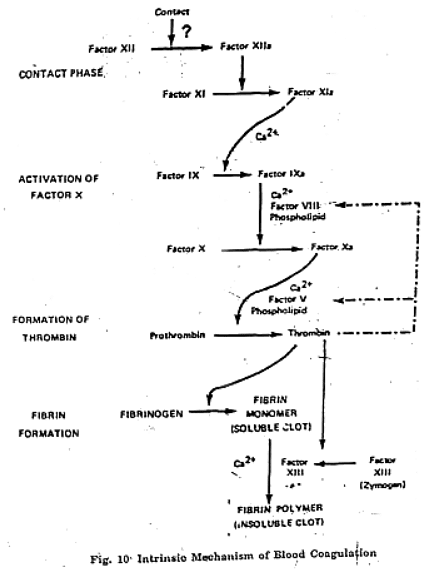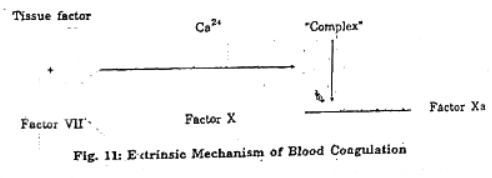Best Study Material for UPSC Exam
UPSC Exam > UPSC Notes > Animal Husbandry & Veterinary Science Optional for UPSC > Mechanism of Coagulation
Mechanism of Coagulation | Animal Husbandry & Veterinary Science Optional for UPSC PDF Download
Blood Clotting Mechanism: Intrinsic Pathway
- Initiation of Coagulation:
- Intrinsic mechanism involves enzymatic reactions triggered when blood encounters a foreign surface.
- Any surface other than the intact endothelial lining of blood vessels is recognized as "foreign" by coagulation proteins and blood cells.
- Damage to vessel walls or exposure to air can kickstart the clotting process.
- Sequence of Enzymatic Reactions:
- Once clotting begins, a series of chain reactions occurs.
- Culminates in the generation of thrombin, a crucial enzyme.
- Leads to the formation of an insoluble fibrin clot.
- Steps in the Process:
- Recognition of a foreign surface activates clotting proteins.
- Series of enzymatic reactions unfolds.
- Eventually, thrombin is produced.
- Thrombin converts soluble fibrinogen into insoluble fibrin, forming a clot.

Blood Clotting Process Simplified
(a) Contact Activation Phase: Triggering Clotting Mechanism:
- Factor XII, a plasma protein, gets activated to become Factor XIIa.
- Various substances like grass, celite, or collagen initiate this conversion.
- These substances cause a change in Factor XII, exposing an enzymatic site.
(b) Activation of Factor X: Effect on Factor IX:
- Factor XIIa activates Factor XI, which, in turn, activates Factor IX.
- Calcium ions are essential for this process.
- Platelet-supplied phospholipids and large protein molecule Factor VIII act as co-factors.
- This complex rapidly converts Factor X to Factor Xa.
(c) Formation of Thrombin: Role of Factor Xa:
- Factor Xa, a proteolytic enzyme, slowly converts prothrombin to active thrombin in the presence of calcium ions.
- Phospholipid and Factor V are required as co-factors, speeding up the reaction.
(d) Formation of Fibrin: Thrombin's Action:
- Thrombin, a specific enzyme, transforms soluble fibrinogen into soluble fibrin.
- Factor XIII enzyme, with calcium ions, catalyzes the process.
- Soluble fibrin turns into an insoluble fibrin clot, trapping platelets, white cells, and red cells.
- This clotting process stops blood flow.

Blood Clotting: Intrinsic and Extrinsic Mechanisms Simplified
- Intrinsic Mechanism:
- Trigger: Traumatic damage to blood vessels and surrounding tissues releases tissue juices.
- Key Component: Tissues contain a specific lipo-peptide, thromboplastin, triggering rapid fibrin formation when entering the bloodstream.
- Role: Responds to everyday minor traumas and injuries to blood vessels.
- Extrinsic Mechanism:
- Trigger: Major traumatic damage causing release of tissue juices.
- Key Component: Thromboplastin from tissues initiates a faster response.
- Role: Complementary system working with intrinsic mechanism to address significant injuries.
- Clotting Process:
- Time Frame: Clotting times vary (2 to 11 minutes) in different species and health conditions.
- Contraction: After hours, the formed fibrin contracts, squeezing out blood serum.
- Vitamin K Requirement: Adequate vitamin K is necessary for prothrombin supply, influencing clotting.
- Inhibition: Clotting can be inhibited by anticoagulants like heparin, warfarin, or in cases of diseases like hemophilia.
- Circulation of Blood:
- Regulation: Circulatory regulation ensures coordination between heart activity and metabolic changes in response to external and internal conditions.
- Complex Reflex Act: Heart activity adapts to changes in the environment and body activity, maintaining a balance in blood circulation.
- Haemorrhage Disorders:
- Categories: Bleeding problems due to defective blood coagulation fall into congenital and acquired categories.
- Importance of Cardiac Regulation: Heart adapts to pump more blood during vigorous activities, highlighting the significance of cardiac regulation.
Question for Mechanism of Coagulation
Try yourself:
What triggers the initiation of the intrinsic pathway in the blood clotting mechanism?View Solution
Blood Disorders Simplified
Anticoagulants: Controlling Blood Clotting
- Chelating Agents:
- Function: Bind calcium ions, preventing their use in coagulation reactions.
- Examples: Sodium oxalate, EDTA (used frequently in laboratories).
- Heparin:
- Function: Most effective anticoagulant, inhibits both thrombin generation and its activity.
- Effect on Coagulant Proteins: Inhibits synthesis of functional coagulant proteins (II, X, VII, IX).
- Vitamin K Antagonists:
- Mechanism: Inhibit synthesis of vitamin K-dependent coagulation proteins.
- Result: Non-functional proteins are synthesized, preventing normal coagulation reactions.
Blood Groups: Genetic Markers
- Blood Group Systems:
- Purpose: Determine blood types based on different antigens on red blood cells.
- Systems Recognized: Vary across species (e.g., 12 in cattle, 15 in swine, 8 in dogs).
- Pleiotropic Effects of Genes:
- Definition: Some genes affect multiple traits simultaneously.
- Implications: Blood group genes with pleiotropic effects may influence economic traits.
- Genetic Applications:
- Genetic Improvement Programs: Blood typing may aid in improving desirable traits.
- Parentage Exclusion: Useful for excluding parentage but cannot prove it.
- Monozygosity of Twins: Can't prove monozygosity but can detect genetic differences in dizygotic twins.
Blood Group Classification and Blood Volume Insights
Blood Group Classification: Understanding Antigenic Nature
- Basis: Blood group classification relies on the antigenic nature of erythrocytes (red blood cells).
- Pioneering Studies: Landsteiner and other researchers laid the foundation for this classification.
- Importance: Crucial for transfusion therapy and medical interventions.
Blood Volume: A Key Parameter
- Significance: Knowing an animal's blood volume is crucial for interpreting various hematological values.
- Parameters Affected: Packed cell volume, hemoglobin, red cell counts, plasma protein concentration.
- Limitations: Hematological values can be misleading; blood volume changes are not reflected.
- Estimation Methods: Indirect techniques, considering factors like dilation, are used.
Plasma Expanders: Restoring Circulating Volume
- Definition: Substances like hypertonic saline, dextran, or hetastarch used to replenish circulating volume.
- Alternatives: Crystalloids, stored plasma can also serve this purpose.
 |
Download the notes
Mechanism of Coagulation
|
Download as PDF |
Download as PDF
Compensatory Mechanisms After Hemorrhage
- Responses to Hemorrhage: Trigger compensatory mechanisms like vessel contraction, fluid shift, vasopressin release.
- Rapid Blood Loss: Severe stress and anemic shock can result from rapid loss exceeding 30 percent of blood volume.
Types of Plasma Expanders and Administration
- Dextrans:
- Administered in infusion fluids (5% dextrose or 0.9% sodium chloride solution).
- Causes slight hyperthermia.
- Hetastarch (Hydroxyethyl Starch):
- Administered as a 5% solution in 0.9% sodium chloride solution.
- Mimics osmotic pressure of plasma proteins.
- Hypertonic Solutions:
- Dextrose, urea, mannitol in appropriate concentrations can be used.
- Other Options:
- Gelatin and Polyvinyl Pyrrolidone (PVP) solutions (4-8% concentration) can also be beneficial.
Blood Buffer Systems: Maintaining pH Balance
- Main Buffer Systems: Bicarbonate, plasma protein, phosphate, and hemoglobin are key blood buffer systems.
- Key Players: Bicarbonate and hemoglobin are particularly crucial in maintaining pH balance.
- Buffer Contributions:
- Bicarbonate: 53%
- Hemoglobin: 35%
- Plasma Protein: 7%
- Phosphates: 5%
- Total Buffering Capacity: Significant, preventing drastic pH shifts even with sudden metabolic acid increases.
Biochemical Tests in Disease Diagnosis: Understanding Lab Results
- Importance: Lab tests aid clinicians in accurate disease diagnosis, prognosis, and treatment assessment.
- Test Types:
- Haematology: Study of blood components.
- Blood Chemistry: Analyzing blood for chemical indicators.
- Urine Examination: Assessing urine for health indicators.
- Mastitis Tests: Detecting inflammation in mammary glands.
- Liver Function Tests: Evaluating liver health.
- Cerebrospinal Fluid Examination: Analyzing fluid around the brain and spinal cord.
- Clinical Semen Examination: Evaluating semen health.
- Clinical Parasitology: Identifying parasites in blood and feces.
- Cultural Examination: Identifying causative organisms and conducting sensitivity tests.
- Significance:
- Aids in arriving at accurate diagnoses.
- Guides prognosis of the condition.
- Assesses the effectiveness of treatments.
Question for Mechanism of Coagulation
Try yourself:
What is the function of chelating agents in controlling blood clotting?View Solution
Biochemical Tests: Insights into Animal Health
- Blood Sugar Examination:
- Hyperglycemia: Indicates conditions like diabetes, convulsions, hyperthyroidism, liver disease.
- Hypoglycemia: Suggests issues like starvation, hypopituitarism, excess insulin therapy, ketosis.
- Calcium Estimation:
- Hypercalcemia: Found in excess vitamin D intake, parathyroid adenoma, renal disease, bone tumors.
- Hypocalcemia: May indicate hypoparathyroidism, vitamin D deficiency, milk fever in cows, rickets.
- Phosphorus Levels:
- Hyperphosphatemia: Seen in renal disease, hypoparathyroidism, vitamin D excess, parturient paresis.
- Hypophosphatemia: Occurs in inadequate phosphorus intake, rickets, vitamin D deficiency.
- Magnesium Levels:
- Hypermagnesemia: Noticed during parturition in older cows, chronic nephritis, oxalate poisoning.
- Hypomagnesemia: Results from inadequate magnesium consumption, grazing on magnesium-deficient pastures.
- Serum Alkaline Phosphatase:
- Increased Levels: Indicate biliary obstruction, liver diseases, bone disorders.
- Dog-Specific: Used as a liver function test.
- Serum Cholesterol:
- Hypercholesteremia: Found in conditions like nephritis, diabetes, pregnancy, hypothyroidism.
- Hypocholesteremia: Associated with hyperthyroidism, low-fat diet, acute infections, liver diseases.
- Liver and Kidney Function Tests:
- Provide insights into the actual conditions of liver and kidneys.
- Globulins in Cerebrospinal Fluid:
- Increased levels may indicate inflammation, encephalitis, abscesses, meningitis, toxoplasmosis.
- Also points to issues like pneumonia, convulsions, ureisis, and hemorrhages.
- Significance of Biochemical Tests:
- Diagnosis: Helps in identifying specific conditions.
- Prognosis: Aids in predicting the course of the condition.
- Treatment Assessment: Evaluates the effectiveness of treatments.
Insights from Diagnostic Tests in Animal Health
- Cerebrospinal Fluid Analysis:
- Favorable Sign: Reduced globulin content indicates subsiding inflammation.
- Increased Levels: Suggest hyperglycemia, encephalitis, spinal cord compression, brain tumors, and abscesses.
- Decreased Levels: Occur in hypoglycemia and acute pyogenic infections.
- Clinical Examination of Semen:
- Essential for Fertility Assessment: Crucial for artificial insemination and management of reproductive health.
- Coital Diseases Control: Helps in monitoring and controlling diseases related to mating.
- Other Diagnostic Tests:
- Tuberculin Test: Detects tuberculosis.
- Jehne's Disease Test: Identifies this specific infectious disease.
- Glanders Test: Screens for glanders infection.
- Di L Test: Rapid test for epizootic lymphangitis.
- Pullorum Disease Test: Rapid test for pullorum disease in poultry.
- Brucellosis Test: Detects brucellosis infection.
- Negri Bodies Test: Screens for rabies.
- Mundes Agglutination Test: Identifies bovine vibriosis.
- Agglutination Test for Avian Mycoplasmosis: Detects mycoplasmosis in birds.
- Surface Fixation Test for Listeriosis: Screens for listeriosis.
- Fluorescent Antibody Technique: Advanced technique for disease confirmation.
- Diagnostic Samples:
- Serum, Heart Blood Swabs, Pus Lesions, Blood Smears: Essential samples for diagnosing various livestock and poultry diseases.
- Muzzle Piece of Biological Test: Specific diagnostic material for disease confirmation.
- Dead Chick Examination: Useful in confirming diseases affecting poultry.
- Significance of Diagnostic Tests:
- Disease Identification: Pinpoints specific illnesses in animals.
- Confirmation: Validates disease presence through advanced testing.
- Livestock and Poultry Health: Essential for maintaining the health and well-being of animals.
Question for Mechanism of Coagulation
Try yourself:
What does hyperglycemia indicate in animals?View Solution
The document Mechanism of Coagulation | Animal Husbandry & Veterinary Science Optional for UPSC is a part of the UPSC Course Animal Husbandry & Veterinary Science Optional for UPSC.
All you need of UPSC at this link: UPSC
FAQs on Mechanism of Coagulation - Animal Husbandry & Veterinary Science Optional for UPSC
| 1. What is the function of the intrinsic pathway in the blood clotting mechanism? |  |
| 2. How does the blood clotting process occur? |  |
Ans. The blood clotting process, also known as coagulation, involves a series of complex steps. When a blood vessel is damaged, the intrinsic and extrinsic pathways are activated. The intrinsic pathway is initiated within the blood and the extrinsic pathway is initiated by tissue factors outside of the blood. These pathways lead to the formation of thrombin, which converts fibrinogen into fibrin. Fibrin forms a mesh-like structure that traps platelets and other blood cells, forming a clot to stop bleeding.
| 3. What are blood disorders? |  |
Ans. Blood disorders refer to medical conditions that affect the components of blood, such as red blood cells, white blood cells, platelets, or plasma. Examples of blood disorders include anemia, leukemia, thrombocytopenia, and hemophilia. These disorders can lead to abnormal clotting, bleeding, or other complications and may require medical treatment.
| 4. What is the role of blood buffer systems in maintaining pH balance? |  |
Ans. Blood buffer systems are essential for maintaining the pH balance in the body. They help regulate the levels of acids and bases in the blood, preventing significant fluctuations in pH. The main blood buffer systems include the bicarbonate buffer system, phosphate buffer system, and protein buffer system. These systems work together to absorb excess hydrogen ions (acids) or release hydrogen ions (bases), maintaining the blood's pH within a narrow range.
| 5. How do biochemical tests provide insights into animal health? |  |
Ans. Biochemical tests are laboratory tests that analyze the chemical composition of biological samples, such as blood or urine. These tests can provide valuable information about an animal's overall health, organ function, and presence of any diseases or abnormalities. Biochemical tests measure various parameters, including enzymes, electrolytes, hormones, and metabolites, which can help veterinarians diagnose and monitor conditions, assess treatment effectiveness, and provide insights into an animal's overall well-being.
Related Searches
























